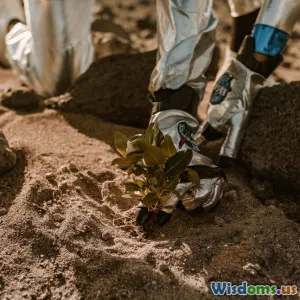
Astrobiology: Searching for Life Beyond Earth
9 min read Explore how astrobiology seeks life beyond Earth, delving into promising worlds, scientific methods, and what future discoveries may unveil. (0 Reviews)
Astrobiology: Searching for Life Beyond Earth
Introduction
From time immemorial, humanity has gazed up at the night sky, wondering if we are alone in the vast cosmos. This primal question has evolved into a dynamic scientific endeavor known as astrobiology—the study of life's origins, evolution, distribution, and future in the universe. Far from science fiction, astrobiology stands at the cutting edge of modern science, leveraging telescopes, robotic missions, and laboratory research to unravel this cosmic mystery.
In this article, we journey through the exciting realm of astrobiology, examining the frameworks scientists use to search for life beyond our planet, the fascinating extraterrestrial environments that might harbor it, and the transformative consequences that finding life would hold for all of us.
What is Astrobiology?
Astrobiology is an interdisciplinary field that integrates astrophysics, planetary science, biology, chemistry, and geology. It explores life's capabilities and limits under extreme conditions to understand where and how life might exist elsewhere.
According to Dr. Nathalie Cabrol, a leading astrobiologist at the SETI Institute, "Astrobiology is fundamentally about understanding the chemistry and environments where life can arise and persist. It's the search to find potentially habitable places and signs of life beyond Earth."
This broad field tackles three critical questions:
- How did life originate on Earth?
- What are the limits of life in extreme environments?
- Where else in the universe could life exist?
Answering these prompts not only teaches us about Earth’s own biosphere but helps target other celestial bodies that may host life.
Key Criteria for Habitability
Scientists assess habitability primarily based on the presence of three factors:
- Liquid Water — Often called the "universal solvent" essential for biochemical reactions.
- Energy Sources — Sunlight, chemical energy from hydrothermal vents, or radioactive decay.
- Organic Molecules and Nutrients — Building blocks like carbon, hydrogen, nitrogen, oxygen, phosphorus, and sulfur.
While life on Earth depends on these conditions, astrobiologists remain open to alternative biochemistries, such as life that might operate on solvents like methane or ammonia under extreme temperatures.
Researchers also consider the planet or moon's atmosphere, geology, magnetic field, and orbit as part of habitability assessment.
Where to Look? Promising Cosmic Neighborhoods
Mars — The Red Planet's Watery Past
Mars has been a focal point for life hunting because it shows evidence of past surface water, including ancient river valleys and lake beds. NASA missions like the Curiosity and Perseverance rovers are analyzing soil samples for organic compounds and biosignatures.
In 2020, Perseverance landed with instruments like SHERLOC—designed to detect organic minerals that could indicate ancient microbial life from over 3 billion years ago.
Europa — A Hidden Ocean World
Jupiter’s moon Europa conceals a vast liquid water ocean beneath an icy crust. The presence of underground water interacting with rocky layers might provide energy and nutrients necessary for life.
The upcoming Europa Clipper mission, planned for launch in the mid-2020s, aims to study this environment in detail—measuring ice thickness, ocean properties, and potential plumes ejecting ocean material into space.
Enceladus — Saturn’s Active Moon
Enceladus, a tiny moon of Saturn, enthralls scientists because of geysers of water vapor and organic-rich ice particles spewing from its southern polar region. Data from the Cassini spacecraft confirms the presence of liquid water, organic molecules, and the chemical energy sources needed for life’s chemistry.
Exoplanets in the Habitable Zone
Beyond our solar system, thousands of exoplanets have been discovered. Space telescopes like Kepler and TESS have identified dozens within the "habitable zone"—the orbital sweet spot where surface temperatures might sustain liquid water.
Notable examples include the TRAPPIST-1 system, with seven Earth-sized planets, several in the habitable zone. Scientists eagerly await new data from the James Webb Space Telescope to analyze atmospheres for biosignatures such as oxygen, methane, or water vapor.
Techniques in the Astrobiologist’s Toolkit
Spectroscopy and Atmospheric Analysis
Astronomers utilize spectroscopy to decipher atmospheric compositions by analyzing the light from stars as it passes through or reflects off planetary atmospheres. Detection of gases out of chemical equilibrium, like enhanced methane alongside oxygen, could hint at biological activity.
Robotic Landers and Rovers
Surface probes carry sophisticated labs to dig, melt, and chemically analyze soil and ice samples. NASA’s Perseverance, for example, collects rock cores intended for eventual return to Earth to search for microfossils.
Remote Sensing and Orbital Observations
Orbiters map mineralogy and surface changes that may be linked to geological or biological processes.
Laboratory Simulation and Extremophile Studies
Scientists also replicate harsh conditions—acidic, radioactive, or cold environments—in labs to understand how life can adapt. Studying extremophiles like microbes inside Antarctic ice or deep-ocean vents expands notions about the resilience of life.
SETI: Listening for Technological Signals
The Search for Extraterrestrial Intelligence (SETI) explores radio waves and light signals that might indicate intelligent civilizations. While still speculative, SETI complements biological searches by focusing on communicative life.
The Profound Implications of Finding Life
Discovering extraterrestrial life—be it microbial or intelligent—would transform science, philosophy, and culture. It would answer one of humanity’s oldest questions and force a reconsideration of our place in the cosmos.
The late NASA Chief Scientist Dr. Ellen Stofan expressed, "Finding a second genesis of life, wherever it may be, would be one of the greatest discoveries of all time. It would suggest life is not unique to Earth, hinting at potentially countless lifeforms beyond."
Furthermore, such discoveries might inform new biochemical pathways, inspire technology, and even impact ethics and law regarding space exploration.
Conclusion
Astrobiology is a frontier science that challenges us to look beyond the familiar for signs of life amidst the stars. Combining rigorous observation, exploration of our solar system, and powerful telescopes peering deep into the galaxy, humanity is closer than ever to answering whether we share this universe or stand alone.
With missions to Mars, Europa, and distant exoplanets, along with the ingenuity of laboratory and theoretical research, the search continues with renewed vigor. The next decades could deliver revolutionary insights into the cosmic abundance—or scarcity—of life.
In the words of famed astronomer Carl Sagan, “The universe is a pretty big place. If it’s just us, seems like an awful waste of space.” Astrobiology dares to prove otherwise.
Rate the Post
User Reviews
Other posts in Planetary Science
Popular Posts
















